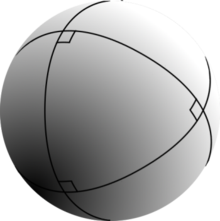
Back حساب المثلثات الكروية Arabic Сферычная трыганаметрыя Byelorussian Сферична тригонометрия Bulgarian Trigonometriezh sferek Breton Trigonometria esfèrica Catalan Sférická trigonometrie Czech Сферăллă тригонометри CV Sfærisk trigonometri Danish Sphärische Trigonometrie German Sfera trigonometrio Esperanto

Spherical trigonometry is the branch of spherical geometry that deals with the metrical relationships between the sides and angles of spherical triangles, traditionally expressed using trigonometric functions. On the sphere, geodesics are great circles. Spherical trigonometry is of great importance for calculations in astronomy, geodesy, and navigation.
The origins of spherical trigonometry in Greek mathematics and the major developments in Islamic mathematics are discussed fully in History of trigonometry and Mathematics in medieval Islam. The subject came to fruition in Early Modern times with important developments by John Napier, Delambre and others, and attained an essentially complete form by the end of the nineteenth century with the publication of Todhunter's textbook Spherical trigonometry for the use of colleges and Schools.[1] Since then, significant developments have been the application of vector methods, quaternion methods, and the use of numerical methods.
- ^ Todhunter, I. (1886). Spherical Trigonometry (5th ed.). MacMillan. Archived from the original on 2020-04-14. Retrieved 2013-07-28.